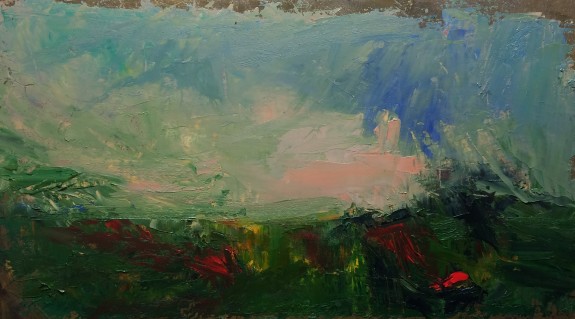I went away, and all my paintings were lined up for slaughter. Then something happened to me. Late at night I fell to my knees in a foreign room – and when I returned they had all become beautiful, beyond my adjusted beliefs.
Fernando Pessoa wrote prose that make me long for a homeland I never knew:
I’ve lived certain moments of respite in the presence of Nature, moments sculpted out of tender isolation, that will always be like medals for me. In these moments I forgot all of my life’s goals, all of the paths I wanted to follow. An immense spiritual tranquility fell into the blue lap of my aspirations and allowed me to enjoy being nothing. But I’ve probably never enjoyed an incorruptible moment, free of any underlying spirit of failure and gloom.
Pessoa, Fernando. The Book of Disquiet (Penguin Modern Classics)

Pessoa continues:
In all my moments of spiritual liberation there was a dormant sorrow, vaguely blooming in gardens beyond the walls of my consciousness, and the scent and the very colour of those sad flowers intuitively passed through the stone walls, whose far side (where the roses bloomed) never ceased being a hazy near side in the obscure mystery of who I am, in the drowsiness of my daily existence.

In the beautiful book “The Poetry of Zen“, the thirteenth century sage Ch’ih-chueh is quoted as saying:
The failure of the Zen path comes from teachers without deep attainment, just setting forth sayings and showing off knowledge to capture students, and from students with no great aspiration just following popular fads and current customs, content to sink themselves in the domain of intellectual knowledge and verbiage…The ‘teachers’ and ‘students’ bewitch each other.
Another sage (Yueh-lin) is quoted as having observed with regards to talking about Zen:
Ninety percent accuracy is not as good as silence
Hello today Open your eyes The snow is falling just like leaves Aquarian warriors rebuild the ship Mr rainbow is gone Hello my love Here's to your heart Unfold the lillies in the deep The season's over, the shores are sealed Now ashen roses rain on the fields Innocent dreamers, look what you've done Now it's time for the phoenix to fly Hello today Wake to the dawn To meet the guardians of the isles The valient captains will rule the seas till the comets return Hello my love Here's to your heart Release that dream into the world Join in the air race, leaving tonight How does it feel to follow the light Beautiful dreamer, it's up to you If we glide through the glamour of love We believe in our dreams Reaching out for above We believe in our dreams Reaching out for love Songwriters: Bernard Lloyd / Marian Gold / Ricky Echolette Fantastic Dream lyrics © Rolf Budde Musikverlag Gmbh
Thanks for visiting my blog. I hope you are happy and content.

It’s good to have you back!
This way that you’re painting these pictures above makes one aware of the edges. Perhaps that wasn’t intentional, maybe yes, maybe no — but I like it. I love the edges of a painting. Bonnard taught me to look at the edges. Something interesting can be happening there too.
How wonderful that you return to beauty.
LikeLiked by 1 person
Thanks Aletha. Yes, if by edges you are referring here to the sides of the picture and not the normal edges between objects in a painting – then yes, I am quite purposefully leaving part of the board and previous painting exposed. I found it works best if the under-surface is the color of wood (something like Raw Umber).
I saw this in the beautiful paintings of John Felsing and was immediately attracted to it. For me, those unfinished edges emphasize that the painting is just a human gesture and that it is after all a flat surface you are looking at. Any idea of a factory produced photo-image is destroyed. Some may not like that, the fact that there is something unfinished in it, something the author left unsaid so that it would not be taken away and hung somewhere.
LikeLiked by 2 people
I did mean the edges of the whole picture — and I’ve just looked up John Felsing — beautiful. It’s good to find these kindred spirits whose ideas become something you can transform into your own life.
LikeLiked by 1 person
Can’t tell you how many times I have revised (or flip-flopped if you prefer) my opinion about one of my paintings without ever having touched it. It usually goes back and forth that way until it doesn’t. Then I know it’s finished.
LikeLiked by 1 person
Well said Alli. I find it is often a reflection of my state of being, or more specifically, my level of self-confidence. But it is of course a fragile balance between arrogance and self confidence. 🙂 Thanks for visiting!
LikeLike
Fritz what a great post, so very enjoyable!
I read your comment about the unfinished edges …… that is, so zen, so beautiful.
So wabi sabi I smiled and got a bit excited. The whole zen approach, contemplative art and wabi sabi appeal to me. A lot more than the regular, standard Western traditional art way. Unfinished, impermanent, imperfect IS beauty. cheers, Debi
LikeLike
Thanks Debi! I started reading a book on Wabi Sabi design a while back, but got waylaid. You inspired me to get into it again.
LikeLiked by 1 person
your approach…. just reminds me so much of wabi sabi (at least my own interpretation, that is) I’m sure that the zen monks have a much stricter take on it than I do. lol
LikeLike
Alphaville! Now THAT is nostalgia!
LikeLiked by 1 person
Ha! Dawn, now you have given away (somewhat) your age! For me this was university days.
LikeLiked by 1 person
High school for me. My university days were more grunge…
LikeLiked by 1 person